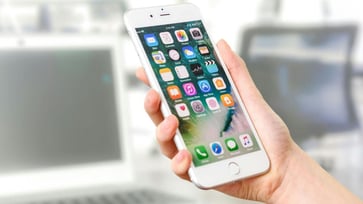A prosthetic hand controlled by a soft robotic armband allows users to move their artificial limb with ease.
Prosthetic hand functionality is being transformed by haptic feedback technology.

Natural hands have long been difficult to replicate with prosthetic hands, limiting users to a single grasp function at a time.
Prosthetics make everyday tasks, such as typing on a keyboard or braiding hair, challenging.
A study from Florida Atlantic University (FAU) presents groundbreaking advancements that could revolutionize the prosthetic hand user's experience.

New technology enables users to grasp two objects at once
A study was conducted by researchers from FAU's College of Engineering and Computer Science and the Charles E. Schmidt College of Science, which involved haptic feedback, electromyogram control, and a wearable soft robotic armband. The aim of this study was to determine if users could control grip forces applied to two different objects simultaneously with a dexterous artificial hand.
The research published in Scientific Reports showed that participants could successfully grasp and transport two objects simultaneously without dropping them, even when visual feedback was blocked, using multiple channels of haptic feedback.
Participants were able to grasp a card with their fingers while simultaneously unscrewing a water bottle lid or flicking a light switch with their little finger.

Multichannel soft robotic armband
The development of a multichannel soft robotic armband that conveys artificial sensations of touch through soft actuators and vibrotactile stimulators was a key innovation in this research. The armband's design enables it to deliver haptic feedback at three critical points corresponding to the thumb, index and little fingers, enhancing the user's ability to control multiple objects simultaneously.
The study's participants found that haptic feedback was more important than visual feedback, as visual cues often failed to indicate when an object was about to fall. This highlights the importance of incorporating tactile sensations into prosthetic technology.

Implications for future prosthetic design
The implications of this study go beyond immediate user benefits; they suggest a paradigm shift in how prosthetic hands could be controlled in the future. By enhancing sensory feedback, this research opens new pathways for individuals with upper limb loss to engage in complex tasks traditionally deemed impossible with current prosthetics, such as playing musical instruments or performing intricate surgical procedures.
The study found that individuals with limb loss were able to perform as well as able-bodied individuals in certain tasks, suggesting that technology can help bridge the gap in functionality for users.

Kurt’s key takeaways
As technology continues to advance, prosthetic hands may soon surpass the abilities of natural hands, allowing users to regain their autonomy and participate fully in daily life and specialized tasks. This cutting-edge method not only overcomes current obstacles but also lays the groundwork for future advancements in assistive technology for people with disabilities.
Can you share any personal experiences or stories related to the use of prosthetics or assistive devices? Please write to us at Cyberguy.com/Contact.
To receive my tech tips and security alerts, sign up for my free CyberGuy Report Newsletter at Cyberguy.com/Newsletter.
Let us know what stories you'd like us to cover.
Follow Kurt on his social channels:
Answers to the most asked CyberGuy questions:
New from Kurt:
Copyright 2025 CyberGuy.com. All rights reserved.
tech

15 things to do or try first when you get a new iPhone: 1. Set up your phone with your personal information and preferences. 2. Install your favorite apps and games. 3. Connect your phone to your Wi-Fi network and other devices. 4. Take a few photos and test out the camera. 5. Set up your email and other accounts. 6. Enable security features like Touch ID or Face ID. 7. Customize your phone's settings and appearance. 8. Explore the built-in features and apps on your phone. 9. Connect with friends and family on social media. 10. Set up reminders and alarms. 11. Use the phone's built-in voice assistant. 12. Download and install new apps from the App Store. 13. Set up your phone's screen time and parental controls. 14. Enable automatic updates for your apps and software. 15. Back up your important data to cloud storage or an external hard drive.
techYou might also like
- Five top home inventory apps to safeguard your property during an emergency
- Your smart home gadgets will soon receive a new security seal of approval.
- This year, save time, privacy, and money with these 10 tech upgrades.
- Is your Windows 11 PC frequently restarting? Let's resolve this annoying issue.
- Sony's entry into the electric vehicle market is a surprising move.


















